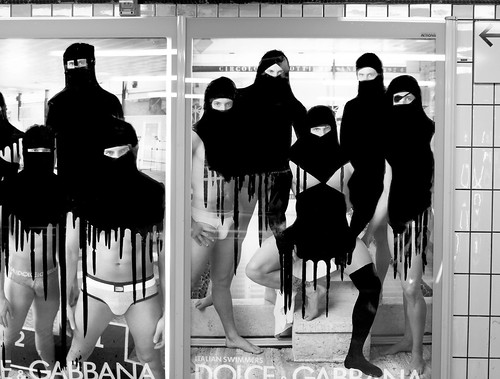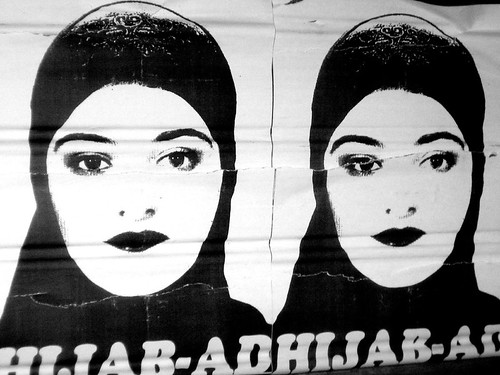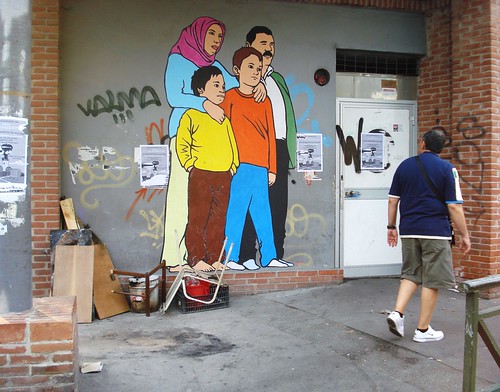Well, its finally here! The piece I put together for Bitch Magazine on Princess Hijab is on their website. It’s so great to see it published as it was a challenging one, not only in terms of content but also having to overcome language barriers (Princess Hijab is French afterall).
Thankfully, the people at Bitch were great and Andi Ziesler was so generous with her time and getting useful feedback to me. Being a young freelancer, the one thing I crave is feedback! Constructive, of course I am only human 
Enjoy. And feedback anyone?
Article by Arwa Aburawa, appeared in issue Art/See; published in 2009; filed under Art.
Since 2006, the elusive guerrilla artist known as Princess Hijab has been subverting Parisian billboards, to a mixed reception. Her anonymity irritates her critics, many of whom denounce her as extremist and antifeminist; when she recently conceded, in the pages of a German newspaper, that she wasn’t a Muslim, it opened the floodgates to avid speculation in the blogosphere. If her claim of being a 21-year-old Muslim girl was only partially true, some wondered what the real message was behind her self-described “artistic jihad.”
In her online manifesto, PH declares that she “acts upon her own free will” and is “not involved in any lobby or movement, be it political, religious, or to do with advertising.” The Princess insists that, like the ape-masked Guerrilla Girls and Mexico’s balaclava-clad Zapatistas, by being nobody, she is free to be anybody. But as liberating as this anonymity may seem, it does leave her work open to conflicting—and occasionally unflattering—interpretations. On the popular blog Art21, critic Paul Schmelzer points to Princess Hijab’s work as an example of right-wing street art, surmising that her motivation is to cover the “shame of omnipresent (and often sexualized) ads.” Another blogger, Evil Fionna, argues that if Princess Hijab were acting as a fundamentalist Christian, her work would be recognized as “religious extremis[m]” that demonizes women and makes them ashamed of their bodies. And a commentator on the anti-Islam site Infidel Bloggers accused the artist of urging women to submit to the “tyranny of Islam.”
These observers also allude to the uncanny similarity between the work of Princess Hijab and that of conservative religious groups that have historically used less literal hijabizing to police the female form. In Saudi Arabia, the 80-year-old government agency known as the Committee for the Promotion of Virtue and the Prevention of Vice is tasked with, among other things, blacking out bare skin wherever it shows up. In line with Sharia law, women in the pages of magazines, on billboards, and in other public images are painstakingly covered up: Katy Perry may be sporting high-waisted hot pants and a tiny top on her cd cover, but once the Committee gets through with it, she’s garbed in a long-sleeved shirt with matching leggings. (The group, notorious for beating up men and women engaged in “immoral behavior,” have also made headlines for banning Valentine’s Day and restricting the sale of cats and dogs, lest they be used by men to attract women’s attention.)
And in the U.K. in 2005, the activists behind Muslims Against Advertising (MAAD) began daubing blobs of paint on the underdressed models in street ads for the likes of Dove and Wonderbra, and in some cases ripping down the posters altogether.
The ongoing conflict over hijabs in her home country does give Princess Hijab’s work an inescapable political context, or what she calls a “shade of provocation.” France’s hijab debates first erupted in 1989 when three high-school girls were suspended after they refused to remove their Islamic headscarves at a school in a suburb of Paris. Successive years of controversy led to former President Jacques Chirac passing a bill in 2004 banning “religious symbols” in schools on the grounds that they clashed with France’s cherished notions of secularization; more recently, President Nicolas Sarkozy upheld the ban on burqas and headscarves in public spaces, stating, “The burqa is not a religious symbol, it is a sign of the subjugation, of the submission of women. I want to say solemnly that it will not be welcome on the territory of the French Republic. We cannot accept women in cages, amputated of all dignity, on French soil.”
But Princess Hijab insists that anyone confusing her work with that of either conservative culture-jammers or Muslims supporting freedom of religious expression is missing the mark. “My work supports right-wing radicalism like Taxi Driver support cabbies. I’m using the hijab for myself.” And looking through her catalog of work, neither label seems right. If her goal really is to cover up the skin-flashing women in ads, then why leave slinky legs on display underneath the painted-on hijabs? And if she’s aiming to make a statement about the dignity of Muslim women, why hijabize male models in Dolce & Gabbana briefs with shoulder-length chadors, leaving their tanned, oiled abs and legs even more preposterously exposed?
 In fact, Princess Hijab asserts, her dressing up of billboards is a symbolic act of resistance meant to reassert a “physical and mental integrity” against what she calls the “visual terrorism” of advertising. Arguing that the human right of expression has been displaced by publicists, advertisers, and the machinery of capitalist, commodified culture, she offers that, “My work explores how something as intimate as the human body has become as distant as a message from your corporate sponsor.”
In fact, Princess Hijab asserts, her dressing up of billboards is a symbolic act of resistance meant to reassert a “physical and mental integrity” against what she calls the “visual terrorism” of advertising. Arguing that the human right of expression has been displaced by publicists, advertisers, and the machinery of capitalist, commodified culture, she offers that, “My work explores how something as intimate as the human body has become as distant as a message from your corporate sponsor.”
“Like that poster of Farah Fawcett,” she continues, “with her teeth clenched in fear above her perfect polyester swimswuit. When she revealed her cancer, we had to see her and her body as something capable of tragedy. It’s that sort of re-humanization that I aim for with hijabization.” Princess Hijab later admitted that this example, and equating wearing the hijab with physical suffering, was a clumsy one, but wanted the point to stand: Her work attempts to remove the hijab from its gendered and religious context and convert it into a symbol of empowerment and re-embodiment.
Equally central to her work is the goal of social equality. She notes that, in France, “You’re always being asked your origin, which religion you follow. It’s something that is very French, actually; you don’t see it in New York or Berlin.” Hinting that she is a racial outsider in France, Princess Hijab states that she is never taken at face value, but instead pushed into a homogeneous social group and then judged by a corresponding set of stereotypes. With stratification by gender, religion, place of origin, and sexuality, she asserts, comes groups that are closed off from one another’s experiences. Even during her time at university, she recalls her modes of expression being explained away by her origins: “I would be told [that it was] ‘natural,’ given my background, that I would work on [one] topic and not on another. I felt trapped.” But by highlighting everyone’s potential “outsider” status by imposing the hijab on public figures, PH asserts that she is “trying to create a connection with and between people.”
 Back when Princess Hijab was believed to be a Muslim, blogger Ethar El-Katatney of Muslimah Media Watch noted, “I’d actually love it if it turns out she’s not a Muslim, because it lends credibility to the idea that the dislike of being exposed to ‘visual aggression’ is not necessarily rooted in religious belief. Fed up with women being used to sell products, hijabizing ads could be a way to ‘take back’ women’s rights to their bodies.” Indeed, in Princess Hijab’s marked-up art, the headscarf is an agent not of covering but of exposure—of the oppressive nature of the advertising industry, of the displacement and disempowerment of women who are repeatedly told that they are not good, skinny, beautiful, sexy, or rich enough. It’s work that owes much more to Adbusters or No Logo than to the Taliban.
Back when Princess Hijab was believed to be a Muslim, blogger Ethar El-Katatney of Muslimah Media Watch noted, “I’d actually love it if it turns out she’s not a Muslim, because it lends credibility to the idea that the dislike of being exposed to ‘visual aggression’ is not necessarily rooted in religious belief. Fed up with women being used to sell products, hijabizing ads could be a way to ‘take back’ women’s rights to their bodies.” Indeed, in Princess Hijab’s marked-up art, the headscarf is an agent not of covering but of exposure—of the oppressive nature of the advertising industry, of the displacement and disempowerment of women who are repeatedly told that they are not good, skinny, beautiful, sexy, or rich enough. It’s work that owes much more to Adbusters or No Logo than to the Taliban.
Though Princess Hijab’s work has gained international notice, like much street art it still actively resists a simplistic reading. And that she uses such a contested icon to wreak artistic revenge on the dual constructs of advertising and social prejudice means her work is ultimately as much about the interpretation of others as it is about her own intent. “People are confused by me,” admits PH. “Some say I am pro-feminist, some say I am antifeminist; some say I am pro-Islam, others that I am anti-Islam. It’s all very interesting—but at the end of the day, I am above all an artist.”
Arwa Aburawa is a freelance journalist based in the United Kingdom.
Link to the Article on the Bitch website.
 Fred Halliday, who died aged 64 in April 2010, wrote widely on many subjects related to the Middle East as well as the Muslim community in the UK, but Shocked and Awed is quite different to his other books. In fact, it’s not really a book but a political dictionary of words, turns of phrases and made up terminology which the general public were exposed to in the aftermath of 9/11 and the subsequent conflicts in Iraq and Afghanistan. Arranged into twelve chapters, the book studies words that have entered our vocabulary, their meaning, their origins but also- and this is the important bit- they way they influence the way we think and subsequently act. As Halliday reminds us “those who seek to control events, people and their minds also seek to control language.”
Fred Halliday, who died aged 64 in April 2010, wrote widely on many subjects related to the Middle East as well as the Muslim community in the UK, but Shocked and Awed is quite different to his other books. In fact, it’s not really a book but a political dictionary of words, turns of phrases and made up terminology which the general public were exposed to in the aftermath of 9/11 and the subsequent conflicts in Iraq and Afghanistan. Arranged into twelve chapters, the book studies words that have entered our vocabulary, their meaning, their origins but also- and this is the important bit- they way they influence the way we think and subsequently act. As Halliday reminds us “those who seek to control events, people and their minds also seek to control language.”
 Read my interview with Gilbert Achcar- a professor of Development Studies at the University of London’s School of Oriental and African Studies- on Arabs, the Holocaust and Palestine.
Read my interview with Gilbert Achcar- a professor of Development Studies at the University of London’s School of Oriental and African Studies- on Arabs, the Holocaust and Palestine. This is where a confession comes in. When I was younger, I used to read Marie Claire, and I have vague memories of enjoying flicking through its pages—even getting excited at its coverage of Muslim women. For my masters in International Journalism, I wanted to look at the representation of Muslim women in the media, and I focused my research on the coverage of Muslim women in women’s magazines and Marie Claire in particular.
This is where a confession comes in. When I was younger, I used to read Marie Claire, and I have vague memories of enjoying flicking through its pages—even getting excited at its coverage of Muslim women. For my masters in International Journalism, I wanted to look at the representation of Muslim women in the media, and I focused my research on the coverage of Muslim women in women’s magazines and Marie Claire in particular.

 In fact, Princess Hijab asserts, her dressing up of billboards is a symbolic act of resistance meant to reassert a “physical and mental integrity” against what she calls the “visual terrorism” of advertising. Arguing that the human right of expression has been displaced by publicists, advertisers, and the machinery of capitalist, commodified culture, she offers that, “My work explores how something as intimate as the human body has become as distant as a message from your corporate sponsor.”
In fact, Princess Hijab asserts, her dressing up of billboards is a symbolic act of resistance meant to reassert a “physical and mental integrity” against what she calls the “visual terrorism” of advertising. Arguing that the human right of expression has been displaced by publicists, advertisers, and the machinery of capitalist, commodified culture, she offers that, “My work explores how something as intimate as the human body has become as distant as a message from your corporate sponsor.” Back when Princess Hijab was believed to be a Muslim, blogger Ethar El-Katatney of Muslimah Media Watch noted, “I’d actually love it if it turns out she’s not a Muslim, because it lends credibility to the idea that the dislike of being exposed to ‘visual aggression’ is not necessarily rooted in religious belief. Fed up with women being used to sell products, hijabizing ads could be a way to ‘take back’ women’s rights to their bodies.” Indeed, in Princess Hijab’s marked-up art, the headscarf is an agent not of covering but of exposure—of the oppressive nature of the advertising industry, of the displacement and disempowerment of women who are repeatedly told that they are not good, skinny, beautiful, sexy, or rich enough. It’s work that owes much more to Adbusters or No Logo than to the Taliban.
Back when Princess Hijab was believed to be a Muslim, blogger Ethar El-Katatney of Muslimah Media Watch noted, “I’d actually love it if it turns out she’s not a Muslim, because it lends credibility to the idea that the dislike of being exposed to ‘visual aggression’ is not necessarily rooted in religious belief. Fed up with women being used to sell products, hijabizing ads could be a way to ‘take back’ women’s rights to their bodies.” Indeed, in Princess Hijab’s marked-up art, the headscarf is an agent not of covering but of exposure—of the oppressive nature of the advertising industry, of the displacement and disempowerment of women who are repeatedly told that they are not good, skinny, beautiful, sexy, or rich enough. It’s work that owes much more to Adbusters or No Logo than to the Taliban.
